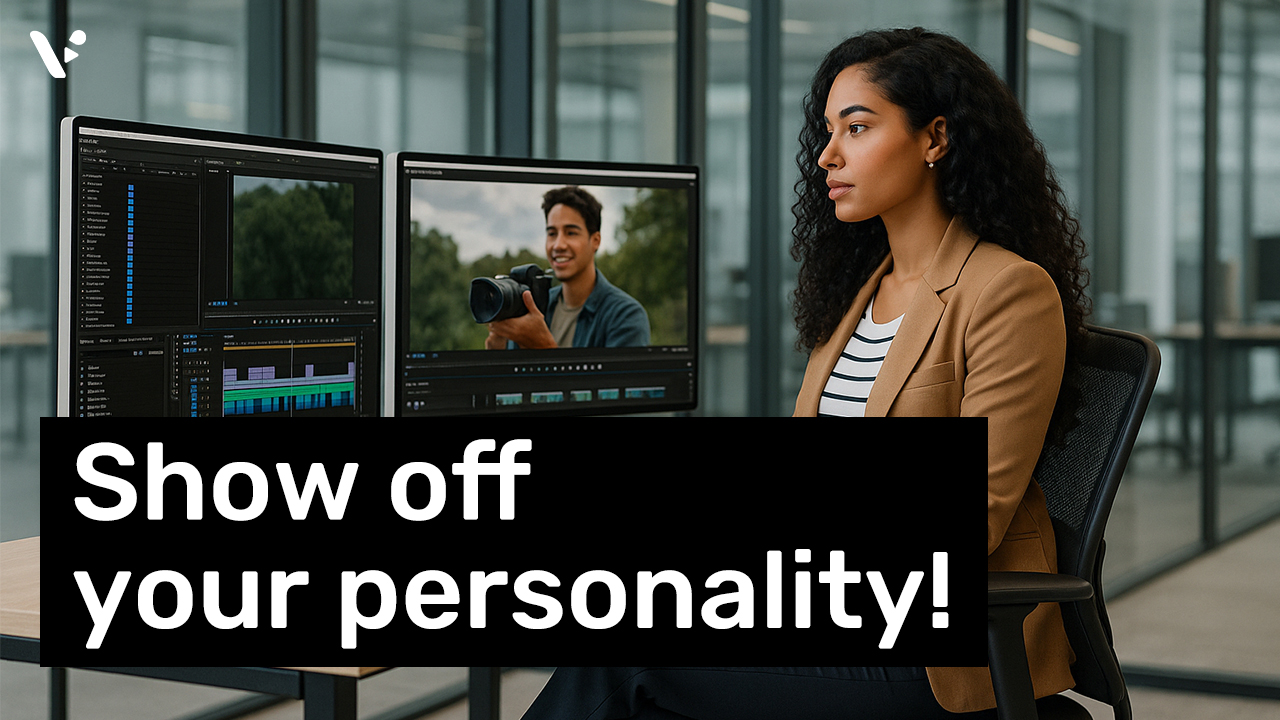Creating a video that feels like you can be tough. But it’s also one of the most rewarding things you can do as a content creator, marketer, or team member. Whether you’re presenting your company, explaining a concept, or pitching an idea, people respond better to something that feels authentic. And the good news? With a little practice and the right tools, you can do this.
Let’s walk through how to create videos that sound, look, and feel like you, and how Visla helps along the way.
Write in your voice
Your voice is more than just the sound of your words or the tone you use. It’s the personality that comes through in the way you explain ideas, the clarity of how you persuade others, and the rhythm of how you connect with your audience. Finding this voice on video doesn’t happen instantly. It takes time, trial and error, and a lot of practice. You develop it by watching your recordings, learning from what works and what doesn’t, and constantly refining. Your voice on video should feel like a natural extension of how you talk in real life: genuine, clear, and confident. Visla makes this process easier by letting you script, record, edit, and review all in one place, so you can focus on growing your voice without getting stuck in the technical details.
How to write a script that sounds like you
Start simple. Write the way you speak. If you wouldn’t say something in a real conversation, don’t put it in your script. Avoid jargon unless it’s part of your field or style. And always read your script out loud. If you trip over a sentence, rewrite it.
Here’s a basic script-writing process to follow:
- Outline your message: What do you want people to walk away with?
- Draft your key points: Write short, clear bullets.
- Expand into full sentences: Keep the tone conversational.
- Read it aloud: Make sure it flows naturally.
- Get feedback: Share it with a teammate.
The more you write and review your scripts, the better they’ll get. With Visla, you can also collaborate with your team in a shared Workspace to refine and finalize scripts together.
Appear on camera (yes, really!)

We get it. Being on camera can feel awkward. You might worry about how you look, how you sound, or what people will think. But here’s the thing: showing your face builds trust. It makes your message more relatable and personal. People are wired to connect with people, and nothing beats a real human presence on screen. If you’re new to this, start small. Record a short intro or a simple update. You don’t have to be perfect; you just have to be present. Visla helps take the pressure off by letting you record in segments, use a built-in teleprompter, and edit out mistakes with just a few clicks. It’s designed to support you, not stress you out. Over time, you’ll get more comfortable and confident, and your viewers will appreciate the real you.
How to use a teleprompter like a pro
Visla’s built-in teleprompter helps you stay on message while sounding natural, but it can still feel intimidating if you’re using one for the first time. Practice reading a few lines before hitting record. It helps you get into the rhythm. If you need to redo a section, no problem; Visla’s multi-segment recorder lets you re-record specific parts without starting from scratch. Like any tool, the teleprompter becomes more intuitive with use, and Visla’s simple design helps flatten the learning curve so you can focus on sounding like your best self on camera.
How to appear confident on camera
- Look into the camera, not your screen.
- Sit up straight, relax your shoulders.
- Smile occasionally. You don’t need to beam nonstop.
- Use your hands, but don’t overdo it.
- Most importantly: be yourself.
You can re-record sections as needed using Visla’s multi-segment recorder, so there’s no pressure to get it perfect in one shot.
Develop your editing style
Your editing style is part of your creative fingerprint, and it influences how your message is received. It isn’t just about making videos look good, it’s about pacing, tone, emotion, and clarity. Think about the videos you enjoy watching. Are they fast-paced and energetic, or slower and more reflective? Do they rely on punchy transitions, quick cuts, or lingering shots? Are the visuals bright and animated or minimal and focused? Noticing these patterns helps you decide what feels right for your own work. Developing your editing style means borrowing from what you like and slowly layering in your own preferences. This process takes time, but it’s a skill you build by experimenting, watching, and refining.
Use Visla to shape your style

With Visla, shaping your editing style is simple and flexible, even if you’re just starting out. Here’s how Visla helps:
- Use brand kits to apply your fonts, colors, and logos automatically across all your projects. This keeps your visuals consistent and professional.
- Visla lets you edit with scenes instead of long timelines. You can:
- Split long scenes
- Shorten slow parts
- Rearrange segments
- Merge clips for smoother flow
- Add visual personality with features like:
- Animated text overlays to highlight key ideas
- Eye-catching transitions between scenes
- Graphics that support your message
- Ken Burns effect to add motion to still images
Whether you want a polished, corporate tone or a casual, personal feel, Visla gives you the freedom to experiment and define your style. The more you create, the more naturally your editing voice will come through.
Make more videos, faster, with Visla
If you want to find your style and voice, the best thing you can do is make a lot of videos. Like with any creative skill, repetition is key. Each time you write a script, record footage, or edit a scene, you get a little better. You start to see what feels right, what doesn’t, and where your personal strengths lie. But creating videos from scratch can be time-consuming, and that’s where Visla’s AI tools come in. They help you get ideas out of your head and onto the screen faster. You don’t need to worry about finding footage, background music, or voiceovers. Visla can take care of that for you.
You can start with something as small as a text prompt or a rough script. Visla will generate a draft video complete with scenes, stock footage, subtitles, voiceovers, and music. While the first version might not be perfect, it gives you a strong foundation. From there, you can refine the visuals, adjust the pacing, tweak the script, or swap in your own footage. Seeing your script take shape in real time is incredibly motivating. It shortens the feedback loop between writing and reviewing, which helps you build your skills faster. Over time, this quick, repeatable process will sharpen your instincts and help you find your unique voice on video.
Get feedback early and often
Feedback is essential. It’s how we improve, how we see our blind spots, and how we grow as communicators. When you’re working on a video, you can get so close to the content that you miss things. Maybe a sentence sounds clear in your head but feels confusing to someone else. Maybe the pacing feels right to you but drags for your audience. Feedback gives you fresh eyes and ears, and that can make all the difference. With Visla’s collaborative tools, this process is simple. Teammates can leave timestamped comments on drafts to point out specific edits and suggest improvements right inside the platform. You can reply, mark items as resolved, and move your project forward without long back-and-forth emails.
Sometimes, one comment is all it takes to tighten your message or fix a rough transition. But more often, ongoing feedback helps you see patterns. You begin to notice how people respond to your delivery, your editing style, or your tone. This kind of insight is invaluable because it sharpens your instincts and helps you create videos that truly resonate. Over time, feedback doesn’t just improve individual videos, it helps you define your voice and grow your confidence. The more you collaborate, the better your videos become. And ultimately, the more your videos will feel like you.

